 |
The Saint of the Day
St. Marciana – January 7
Prof. Plinio Corrêa de Oliveira
Biographical selection:
At the end of the 3rd century in Rusuccur, a small city in Mauretania, Algeria, there lived a young lady called Marciana, as pious as she was beautiful. While very young, she consecrated her virginity to God, and abandoned everything to live in a cave near that Roman city.
One day, certainly moved by some divine inspiration, she left her cell to walk among the agitated and restless multitude of that city, for this was the time of the bloody persecution of Christians made by Diocletian throughout the Roman Empire.
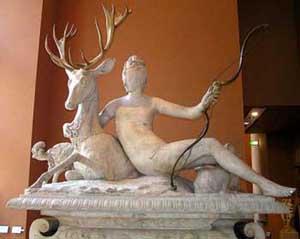
God gave St. Marciana the strength to destroy the statue of the goddess Diana - Louvre Museum |
Entering the city by the Tipasia door, Marciana saw a marble statue of the goddess Diana in the middle of a square. At its feet flowed clear waters in a pool also made of marble. The brave virgin could not bear the sight of that impure idol. She stepped forward and threw the idol from its base, broke its head and smashed the entire statue into pieces.
A furious mob dragged her to the Pretorium before an imperial magistrate. The Christian virgin laughed at the stone and wood gods, and glorified the true God she adored. In loud, eloquent words, she praised Him there in the Pretorium. The pagan judge handed her over to the gladiators to be infamously abused at their pleasure. Marciana remained fearless and serene. For three hours the gladiators were rendered immobile by an unknown terror, and were unable to touch the virgin. Through her prayers one of them converted and professed Jesus Christ as the true God.
Confused by this development of events, the judge remained firm in his hatred. Unable to dishonor the virgin, he condemned her to be torn to pieces by wild beasts. When the hour arrived, she entered the arena as to a joyful feast, giving praise and thanks to Jesus Christ. She was tied to a stake and a lion was set upon her. The beast, however, approached her, touched her breast with its claws, and then retired as though moved by a stronger force.
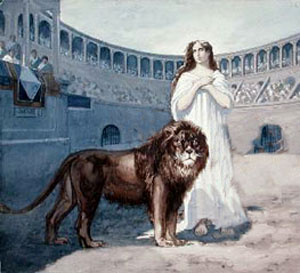
St. Marciana was not harmed by the lion in the arena |
In admiration, the populace called out loudly demanding that she be set free. But a group of Jews who were part of the multitude, always thirsty for Christian blood, changed the mood of the crowd by calling for a wild bull. The beast gored the breast of Marciana opening a terrible wound. The blood poured out and St. Marciana fell to the sand in agony. Servants removed her from the arena, stopped the hemorrhaging, and nurtured what little life remained to her.
The judge, however, called for her to be tied to the stake again. She raised her eyes to Heaven, a smile illuminating her face marked by suffering, and spoke her last words:
O Christ, I adore and love Thee. Thou wert with me in the prison and kept me pure. Now Thou dost call me – O my Divine Master – and I go happily to Thee. Receive my soul.
After she spoke these words, a ferocious leopard tore her apart, opening the road of Heaven to her.
Comments of Prof. Plinio:
It is a most beautiful selection that deserves some comments from a perspective different from the first that appears.
What we see at first sight is the spectacle of an extraordinary, startling and miraculous heroism. Marciana was a hermit near a small city in Africa during a time when Northern Africa was made up of Roman colonies as Latinized as Eastern Europe. St. Marciana, as the name indicates, was probably a Latin young woman. One day, touched by grace, she went to the city. She came across a statue of Diana, goddess of the hunt, placed over a fountain in a public square. She was overcome by a just ire against that idol, a symbol affirming a religion opposed to the religion of Our Lord Jesus Christ.
In this episode, St. Marciana revealed a strength that is not natural. The selection presents her as gracious and beautiful, which normally supposes fragility in a woman. But she became strong enough to push the idol from its base, separate the head from the body, and smash the entire statue to pieces.
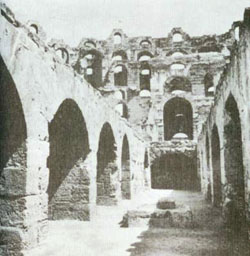
Ruins showing the underground of a Roman amphitheater where wild beasts were kept |
From a Roman point of view, this was a great crime. For a pagan, a statue is not only a representation of the god, but the god itself. They imagine the god is inside the idol, which is why they are called idolaters.
So, filled with a beautiful epic spirit, she pushed the idol to the ground. The fragile, young, and recollected hermit went to the city to accomplish a task that strong Catholic men did not have courage to do: she broke the idol into pieces.
Then, she stood before the tyrannical magistrate who, on behalf of Emperor Diocletian, was condemning all Catholics to death. She faced death with serenity. Here also she gave a demonstration of the strength of God.
Next, the magistrate handed her over to the gladiators, persons of the lowest level, to abuse her as they so desired. Something truly incredible happened. She loved virginity above all else on earth, yet she remained serene in that distressing situation. For three hours those men strong enough to do whatever they liked were rendered immobile and could not approach her. A mysterious force prevented them. One of these gladiators converted, confirming the supernatural presence of God.
Then, the judge condemned her to be killed by wild beasts in the arena. A lion approached her, but only touched her and then walked away. It was yet another intervention of God. The populace felt this and called for clemency. But the Jews, always experts in maneuvering public opinion, created an agitation that moved the fickle crowd from clemency to anticipation for another spectacle. They called for a bull to enter the arena against her.
What pagan ferocity did not achieve, Jewish perfidy managed to do. God defended St. Marciana against the former; He did not defend her against the Jews. With a strong blow the bull gored her. The purple blood of that maiden gushed abundantly from the wound. Some tried to save her, but to no avail; a leopard was released and it killed her. She died joyfully, calling out the name of God Our Lord and announcing her entrance into Heaven.
This is what one sees at first glance in the episode.
Deepening the analysis
But we can go deeper. What is the significance of St. Marciana’s epopee? Was it only a manifestation of Catholic faith before Paganism?
God worked a series of miracles through her. Those miracles were to bear witness to the truth of the Catholic Faith and contribute to the conversion of the peoples of the Mediterranean basin. The great work of the Church in the first centuries was the conversion of those Mediterranean peoples. Because they converted, the barbarian Germanic tribes would convert later. And from them came the Middle Ages and Christian Civilization.
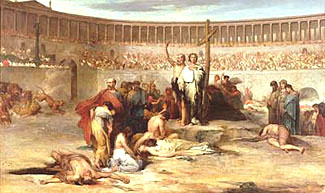
The Triumph of Faith by Eugene Thirion, 19th century |
The Apostles who preached in the far corners of the world were not received by the peoples they addressed. St. Thomas went to India, St. Mark to Ethiopia, others to different places. Their missions were totally or partially rejected.
However, by a special design of Divine Providence, the enormous number of martyrs throughout the Roman Empire and the incredible quantity of miracles related to their deaths served to convert those peoples of the Mediterranean basin. The miracles were more than simple facts – the lion approached St. Marciana but could not devour her, the gladiators were unable to abuse her, etc. Those miracles revealed the beauty of Catholic doctrine, the beauty of the Catholic Civilization to come.
It would be the civilization of virginity facing concupiscence; the civilization of the weak dominating the strong, spirit directing matter; the civilization raised by those who know that nothing is impossible for persons who have faith. Everything fragile, true, and dignified would start to dominate over what represented brute material strength. After original sin, brute strength was accustomed to dominate, but from this point on, the law changed. In the martyrdom of St. Marciana, the bell of a new historic era rang. This is the deeper meaning of the epopee of St. Marciana.
Why did the Church need martyrs?
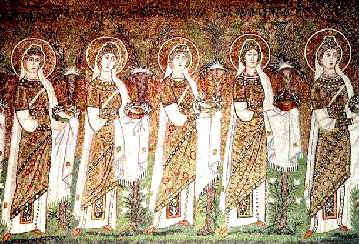
The Procession of Virgin Martyrs on the walls of Sant'Apollinare Nuovo in Ravenna, Italy
|
Someone could ask: Why didn’t God let those martyrs win the fight against Paganism? Why did so many people have to die without making any resistance? Why didn’t so many miracles achieve victory?
One of the indisputable evidences that our Catholic Faith is true is the testimony of the martyrs. This proof will remain until the end times.
It was not just a matter of winning, but of giving a proof of the Faith for future centuries.
The facts reported in the Gospel on the life and teaching of Our Lord were witnessed by many people. Those people were dispersed throughout the Roman Empire by the pressure exerted by Vespacian, Titus and Adrian over the Jewish nation. Some of those Jews became Catholics, but others became our worst enemies. With their calumnies they pretended that the life and doctrine of Our Lord was false. Doing this, they wanted to raise insecurities in those who believed that the Gospel was true and to make Catholicism look like a small sect.
God called the martyrs to counter-attack this offensive and to affirm until the end of the world that Jesus Christ and His doctrine are true and that the Catholic Church is the only true Religion. These martyrs believed so firmly in these truths that they died bearing witness to them. They allowed themselves to be killed without fighting back in order to prove that the Catholic Faith is true. There is no better proof. Pascal used to say: “I believe the words of those who let themselves be mangled.” He was right. To confirm the truth of the Catholic Faith, the martyrs let themselves be torn apart and mangled.
With this, one can understand why Divine Providence gave those persons a heroism that was not to counter-attack and conquer, but to bear the affronts and die. Those millions and millions of martyrs who had such great certainty in the Catholic Faith offer an irrefutable proof.
That is why Divine Providence gave St. Marciana the strength to push over the idol and destroy it, but did not give her strength to throw the Roman magistrate to the ground and kill him. It was necessary for her first to resist the trials miraculously, and then to perish. While she was breaking the idol and resisting, she proved that God was with her. Once this proof was evident, the moment arrived for her to bear witness to the Faith. Then she died a martyr and her example passed to history.
This episode offers a broader perspective for us: it shows how God acted over public opinion in History.
Let us pray to St. Marciana asking her to help us be faithful to our counter-revolutionary vocation as she was to her vocation of martyr.


  |
|
Prof. Plinio Corrêa de Oliveira | |
The Saint of the Day features highlights from the lives of saints based on comments made by the late Prof. Plinio Corrêa de Oliveira. Following the example of St. John Bosco who used to make similar talks for the boys of his College, each evening it was Prof. Plinio’s custom to make a short commentary on the lives of the next day’s saint in a meeting for youth in order to encourage them in the practice of virtue and love for the Catholic Church. TIA thought that its readers could profit from these valuable commentaries.
The texts of both the biographical data and the comments come from personal notes taken by Atila S. Guimarães from 1964 to 1995. Given the fact that the source is a personal notebook, it is possible that at times the biographic notes transcribed here will not rigorously follow the original text read by Prof. Plinio. The commentaries have also been adapted and translated for TIA’s site.
|
Saint of the Day | Home | Books | CDs | Search | Contact Us | Donate

© 2002- Tradition in Action, Inc. All Rights Reserved
|
 |
|